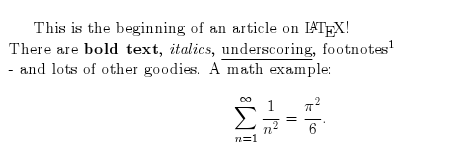LaTeX: Difference between revisions
Jump to navigation
Jump to search
imported>Morten Juhl-Johansen Zölde-Fejér No edit summary |
imported>Morten Juhl-Johansen Zölde-Fejér No edit summary |
||
| Line 26: | Line 26: | ||
\end{document} | \end{document} | ||
Output: | Output:<br/> | ||
[[Image:Latex-eksempel.png]] | [[Image:Latex-eksempel.png]] | ||
Revision as of 01:31, 13 August 2007
LaTeX is a markup language for generating print-quality typesetting.
It is mostly used academic circles, primarily in the natural sciences, for creating material for scientific publications. LaTeX is very well-equipped for displaying formulae and diagrams.
How it works
A LaTeX document structure is split in two: There is a preamble, which indicates some basic, overall features of the document, and there is the main document with the relevant markup for formatting.
The document is initially created as a flat file
Code example
\documentclass[12pt,a4paper,notitlepage]{article}
\usepackage[utf8x]{inputenc}
\usepackage{ucs}
\usepackage{amsmath}
\usepackage{amsfonts}
\author{Morten Juhl Johansen}
\title{LaTeX article}
\begin{document}
This is the beginning of an article on \LaTeX!\\
There are \textbf{bold text}, \textit{italics}, \underline{underscoring}, footnotes\footnote{this is a footnote}\\
- and lots of other goodies. A math example:
\begin{equation*}
\sum_{n=1}^\infty
\frac{1}{n^2}= \frac{\pi^2}{6}.
\end{equation*}
\end{document}
Literature
- Kopka, Helmut; Daly, Patrick W.: Guide to LaTeX. 4th edition. Addison-Wesley Professional, 2003. ISBN 0-321-17385-6.
- Lamport, Leslie: LaTeX: A document preparation system: User's guide and reference. 2nd edition, Reading, Mass. Addison-Wesley Professional, 1994. ISBN 0-201-52983-1.
